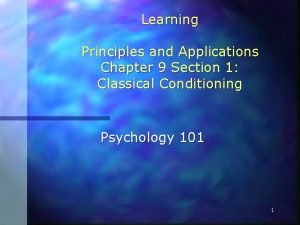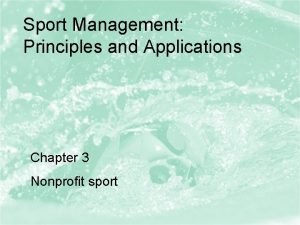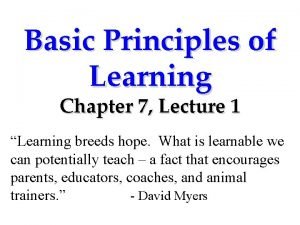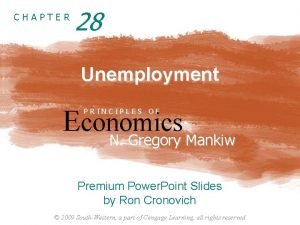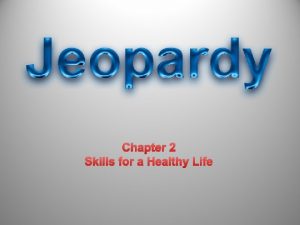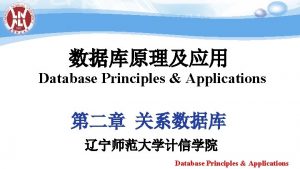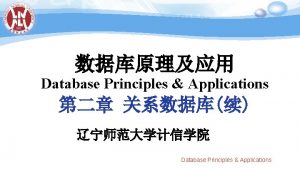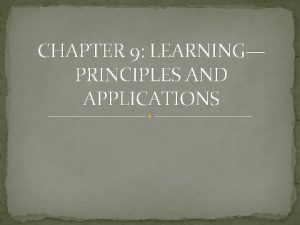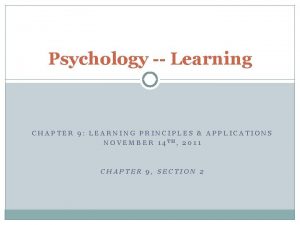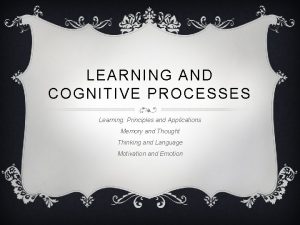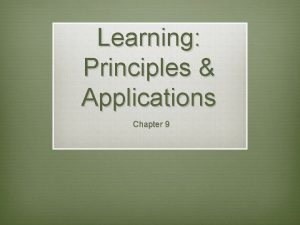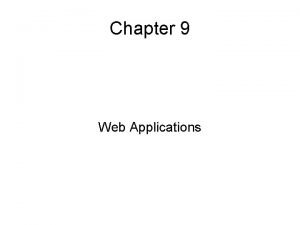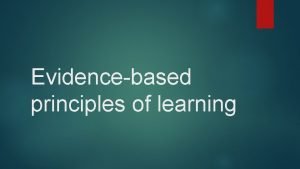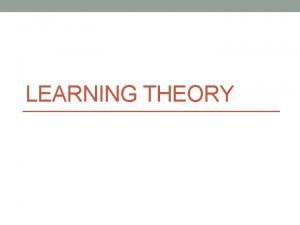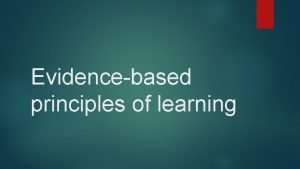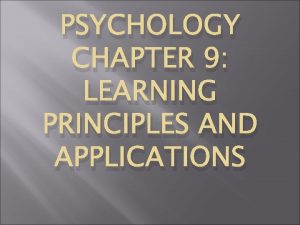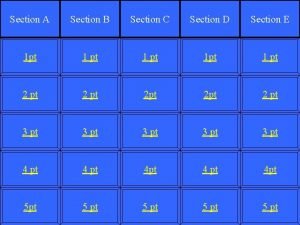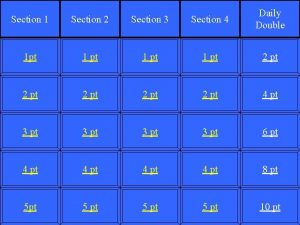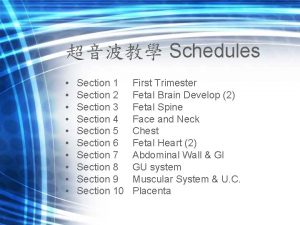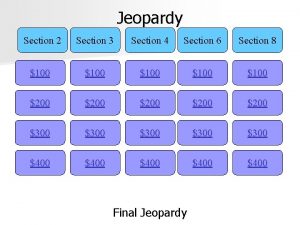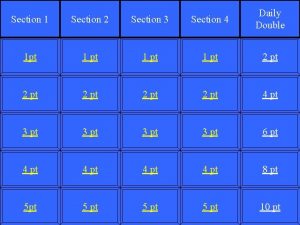Learning Principles and Applications Chapter 9 Section 1


























- Slides: 26

Learning Principles and Applications Chapter 9 Section 1: Classical Conditioning Psychology 101 1

Learning Objectives: Describe the principles of classical conditioning Outline the techniques of classical conditioning 2

Defining Learning refers to the relatively permanent change in behavior (or potential for behavior) brought about by experience, provided that the change cannot be explained on the basis of a simpler cause (e. g. , native response tendencies, maturation, or temporary states such as fatigue, drugs, etc. ). Norris Edwards: Chapter 8: Wade 08. ppt 3

Conditioning involves forming associations between environmental stimuli and responses: Two types of conditioning are: Classical Conditioning Operant Conditioning Norris Edwards: Chapter 8: Wade 08. ppt 4

New Reflexes from Old Pavlov was the first to describe and document the form of learning we now call classical conditioning. Learning with classical conditioning occurs when a neutral stimulus is regularly paired with an Unconditioned Stimulus(US) than elicits a conditioned response (CR) that is similar to the original, unlearned one. Norris Edwards: Chapter 8: Wade 08. ppt 5

Classical Conditioning Defined Classical Conditioning is the process by which a previously neutral stimulus acquires the capacity to elicit a response through association with a stimulus that already elicits a similar or related response Norris Edwards: Chapter 8: Wade 08. ppt 6

Pavlov’s Apparatus Harness and fistula (mouth tube) help keep dog in a consistent position and gather uncontaminated saliva samples They do not cause the dog discomfort Norris Edwards: Chapter 8: Wade 08. ppt 7

Norris Edwards: Chapter 8: Wade 08. ppt 8

Principles of Classical Conditioning Acquisition Extinction Spontaneous Recovery Generalization Discrimination 9

Principles of Classical Conditioning Acquisition Acquiring the conditioned response occurs gradually With each pairing of the conditioned response and the unconditioned stimulus, the conditioned response is strengthened. Timing: Presenting the CS about ½ second before the US yields the strongest associations 10

Principles of Classical Conditioning Extinction If, after conditioning, the conditioned stimulus is repeatedly present without the unconditioned stimulus, the conditioned response will eventually disappear. Extinction is the weakening and eventual disappearance of a learned response in classical conditioning. It occurs when the conditioned stimulus is no longer paired with the unconditioned stimulus 11

Principles of Classical Conditioning Spontaneous Recovery Once a CR is extinguished, it does NOT mean that it is completely unlearned. Spontaneous Recovery: After a period of time, the CR may reappear when the CS is presented again without the US Note that the CR does not return to full strength 12

Acquisition and Extinction Norris Edwards: Chapter 8: Wade 08. ppt 13

Extinction Curve Norris Edwards: Chapter 8: Wade 08. ppt 14

Spontaneous Recovery Norris Edwards: Chapter 8: Wade 08. ppt Page: 15

Principles of Classical Conditioning Stimulus Generalization After conditioning, the tendency to respond to a stimulus that resembles one involved in the original conditioning In classical conditioning, it occurs when a stimulus that resembles the Conditioned Stimulus (CS) elicits the Conditioned Response (CR) 16

Principles of Classical Conditioning Stimulus Discrimination The tendency to respond differently to two or more similar stimuli; in classical conditioning, it occurs when a stimulus similar to the Conditioned Stimulus fails to evoke the Conditioned Response. 17

Stimulus Generalization and Discrimination Pavlov conditioned a dog to salivate at the sight of a circle (CS) The dog also salivated to an oval Dog eventually learned to salivate to the circle and not the oval. How do you think this happened? 18

What is Actually Learned in Classical Conditioning For effective conditioning to occur, it is not enough to pair the stimuli The neutral stimulus must reliably signal the unconditioned one. Because real life is anything but consistent, conditioning is less certain in everyday life. Norris Edwards: Chapter 8: Wade 08. ppt 19

Classical-conditioning terms can be hard to learn, so let’s practice: Name the unconditioned stimulus, unconditioned response, neutral stimulus, conditioned stimulus, and conditioned response in this situation. Five-year-old Samantha is watching a storm from her window. A huge bolt of lightning is followed by a tremendous thunderclap, and Samantha jumps at the noise. This happens several more times. There is a brief lull and then another lightning bolt. Samantha jumps in response to the bolt. US ______ UR ______ NS ______ CS ______ Norris Edwards: Chapter 8: Wade 08. ppt 21 CR ______

Classical-conditioning terms can be hard to learn, so be sure to take this quiz before going on. Name the unconditioned stimulus, unconditioned response, neutral stimulus, conditioned stimulus, and conditioned response in this situation. Gregory’s mouth waters whenever he eats anything with lemon in it. One day, while reading an ad that shows a big glass of lemonade, Gregory notices his mouth watering. US ______ UR ______ NS ___________ CR ______ Norris Edwards: Chapter 8: Wade 08. ppt 21

Classical Conditioning in the Real World John Watson Was One of the Pioneers and the First to Recognize the Implications of Pavlovian Theory in Real Life. Watson Founded the American Behaviorism and Promoted Pavlovian Ideas Particularly in the Areas of Advertisement. Norris Edwards: Chapter 8: Wade 08. ppt 22

Watson’s Extreme Environmentalism “Give me a dozen healthy infants, wellformed, and my own special world to bring them up in, and I’ll guarantee to take any one at random and train him to be any type of specialist I might select - doctor, lawyer, artist, merchant-chief, and yes, beggar-man and thief, regardless of his talents, penchants, tendencies, abilities, vocations, and race of his ancestors. ” John Broadus Watson, 1928 Norris Edwards: Chapter 8: Wade 08. ppt 23

Learning to Like Madison Avenue has made excellent use of the principles classical conditioning. For example, Gorn (1982) discusses an experiment where two groups of students were shown one or two slides of a beige or blue pen. The blue pen was associated with a popular modern song while the beige pen was paired with more traditional Indian music. When asked to express their preference, more than 3/4 s of the student selected the blue pen. Why? Norris Edwards: Chapter 8: Wade 08. ppt 24

Learning to Fear Just as positive association can be established using classical conditioning, negative associations can also be formed. Watson and Rosalie Rayner (1920) deliberately establishing a rat phobia in an 11 -month-old boy named Albert to demonstrate how we learn to fear. Norris Edwards: Chapter 8: Wade 08. ppt 25

In Summary Classical Conditioning helps animals and humans predict what is going to happen. Can you predict the following? Sample One Sample Two Sample Three 26
 Learning principles and applications
Learning principles and applications Cuadro comparativo e-learning m-learning b-learning
Cuadro comparativo e-learning m-learning b-learning Terahertz spectroscopy principles and applications
Terahertz spectroscopy principles and applications Sport management principles and applications
Sport management principles and applications Principles and applications of electrical engineering
Principles and applications of electrical engineering Pearson engineering
Pearson engineering Chapter 7 principles of learning
Chapter 7 principles of learning Principles of ecology chapter 2
Principles of ecology chapter 2 Chapter 2 principles of ecology answer key
Chapter 2 principles of ecology answer key Principles of ecology chapter 2
Principles of ecology chapter 2 Chapter 2 section 1 organisms and their relationships
Chapter 2 section 1 organisms and their relationships Principles of network applications in computer networks
Principles of network applications in computer networks Principles of network applications
Principles of network applications Chapter 10 section 1 meiosis answer key
Chapter 10 section 1 meiosis answer key Conic sections real life
Conic sections real life 13-2 manipulating dna
13-2 manipulating dna Application software and system software difference
Application software and system software difference How do you steer straight forward and backward
How do you steer straight forward and backward Chapter 28 unemployment problems and applications answers
Chapter 28 unemployment problems and applications answers The life skill practicing wellness is
The life skill practicing wellness is Pla tools and techniques
Pla tools and techniques End goals of mtb-mle
End goals of mtb-mle Inductive and analytical learning
Inductive and analytical learning Focl in machine learning
Focl in machine learning Eager vs lazy
Eager vs lazy Tony wagner's seven survival skills
Tony wagner's seven survival skills Half-section
Half-section
